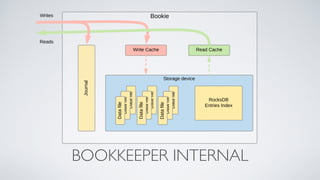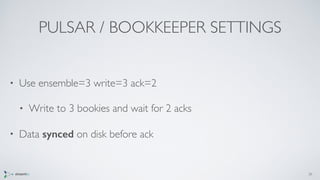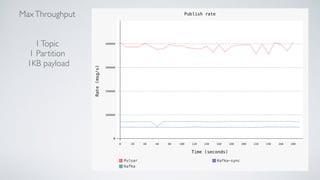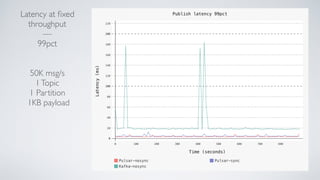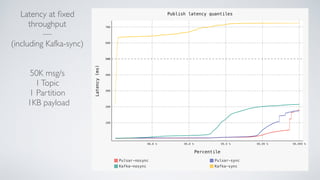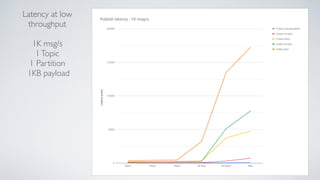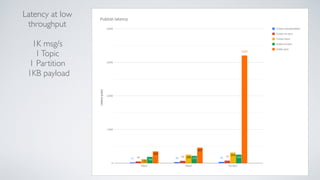High performance messaging with Apache Pulsar
- 1. HIGH PERFORMANCE MESSAGING WITH APACHE PULSAR http://pulsar.apache.org
- 2. WHAT IS PULSAR? “Pub-Sub messaging backed by durable log storage”
- 3. WHAT IS APACHE PULSAR? 3 Multi-tenancy A single cluster can support many tenants and use cases Ordering Guaranteed ordering Durability Data replicated and synced to disk Delivery Guarantees At least once, at most once and effectively once Highly scalable Can support millions of topics Unified messaging model Support both Topic & Queue semantic in a single model Geo-replication Out of box support for geographically distributed applications High throughput Can reach 1.8 M messages/s in a single partition Low Latency Low publish latency of 5ms at 99pct
- 6. DISTRIBUTEDVSVERTICAL • Focus is very different • While both target overall system performance • Distributed systems generally focus on distributed perf 6
- 7. DISTRIBUTED SYSTEMS PERFORMANCE • Key factors: • How different components interact • How data is replicated • Can each component make progress while waiting for other 7
- 8. STATEFUL SYSTEMS • Macro optimizations typically yield orders of magnitude differences • Ensure throughput is not bottlenecked by waiting • In failure path (eg: how to replace a failed node) • In ops tasks (eg: how to expand a cluster) 8
- 9. STATEFUL SYSTEMS • Stateful systems can become unbalanced when traffic changes • The system needs to be designed to allow for quick reaction, distributing the load across all nodes 9
- 10. VERTICAL OPTIMIZATIONS • Ensure a single machine can give the max throughput • Optimize thread access • Concurrent data structures • Micro-Profiling 10
- 12. SEGMENT CENTRIC STORAGE • In addition to partitioning, messages are stored in segments (based on time and size) • Segments are independent from each others and spread across all storage nodes
- 13. SEGMENT CENTRIC • Unbounded log storage • Instant scaling without data rebalancing • High write and read availability via maximized data placement options • Fast replica repair — many-to-many read 13
- 15. COMPARISON WITH APACHE KAFKA • In Kafka, partitions are sticky to brokers • A single partition is stored entirely in a single node • Retention is limited by a single node storage capacity • Failure recovery and capacity expansion require “rebalancing” • Rebalancing has a big impact over the system, affecting regular traffic 15
- 16. DATA PATH 1 — Publisher sends message to broker
- 17. DATA PATH 2 — Broker writes in parallel to N replicas
- 18. DATA PATH 3 — Wait for a quorum of acks from bookies
- 19. DATA PATH 4 — Send ack to producer — Dispatch to consumer
- 20. BOOKKEEPER REPLICATION MODEL • Single writer (Pulsar broker) • Write in parallel to multiple storage nodes • Wait for a configurable number of acks • Supports quorum writes (eg: write 3 nodes — wait 2 acks) • Perform recovery only after writer crashes • Establish what was the last committed entry and “seal” the segment 20
- 21. KAFKA REPLICATION MODEL ISR replication
- 22. LIMITATIONS OF KAFKA REPLICATION • When followers are “in-sync”, the leader will have to wait for them — cannot prune the slowest follower • Leader election happens per partition • To ensure ordering, only 1 message (or batch) can be outstanding — limits throughput • Reads can only happen from leader broker 22
- 23. STORAGE
- 24. STORAGE • Disk access patterns can lead to order of magnitude differences • Systems that rely on page-cache have unpredictable performance • Page cache is RAM speed until the system is under stress • After that, memory accesses can take 100s of millis 24
- 26. BOOKKEEPER STORAGE • IO isolation between write and read operations • Slow consumers won’t impact latency • Very effective IO patterns: • Journal — append only and no reads • Storage device — bulk write and sequential reads • Number of files is independent from number of topics 26
- 27. KAFKA STORAGE • Multiple files per each partitions — each segment has data • Lot of file descriptors needed • Page cache only works well until active data set exceed RAM size • IO is scattered throughout the disk 27
- 28. OPTIMIZATIONS
- 29. OPTIMIZATIONS • Payload Buffer pooling — Direct memory — No heap pollution • Object pooling in data path — minimize GC work • Serialize operations to thread to avoid mutex contention • Pulsar brokers acts as a “proxy” — Payloads are forwarded with zero-copies from producers to storage and consumers 29
- 30. BENCHMARK
- 32. BENCHMARK FRAMEWORK • Designed to measure performance of distributed messaging systems • Supports various “drivers” (Kafka, Pulsar, RocketMQ, RabbitMQ) • Automated deployment in EC2 • Configure workloads through aYAML file 32
- 33. DISTRIBUTED EXECUTION Coordinator will take the workload definition and propagate to multiple workers — Collects and reports stats
- 34. BENCHMARK RESULTS • Testing goals • Throughput & latency under different conditions • Min 2 guaranteed copies • Running on 3 EC2VMs with local SSDs 34
- 35. KAFKA SETTINGS • Topic settings replicationFactor=3 min.insync.replicas=2 log.flush.interval.ms= # Using default: means no fsyncs • Kafka producer config acks=all linger.ms=1 batch.size=131072 35
- 36. PULSAR / BOOKKEEPER SETTINGS • Use ensemble=3 write=3 ack=2 • Write to 3 bookies and wait for 2 acks • Data synced on disk before ack 36
- 38. MaxThroughput — Exactly once producer 1Topic 1 Partition 1KB payload — Kafka settings: enable.idempotence=true max.in.flight.requests.per.connection=1 retries=2147483647
- 39. Latency at fixed throughput 50K msg/s 1Topic 1 Partition 1KB payload
- 40. Latency at fixed throughput — 99pct 50K msg/s 1Topic 1 Partition 1KB payload
- 41. Latency at fixed throughput — (including Kafka-sync) 50K msg/s 1Topic 1 Partition 1KB payload
- 42. Latency at fixed throughput — 99pct 50K msg/s 1Topic 1 Partition 1KB payload
- 43. OPTIMIZING FOR LOW LATENCY • Testing at a smaller throughput for sub-millisecond latency • Tested on bare metal server • Single machine to isolate impact of slow networks 43
- 44. HARDWARE SETUP • 1 Machine — Bare metal • 12 CPU cores — Intel(R) Xeon(R) CPU E5-2687W v4 @ 3.00GHz • 128 GB RAM • 2 x 1.2TB NVMe disks 44
- 45. Latency at low throughput 1K msg/s 1Topic 1 Partition 1KB payload
- 46. Latency at low throughput 1K msg/s 1Topic 1 Partition 1KB payload
- 47. Latency at low throughput 1K msg/s 1Topic 1 Partition 1KB payload
- 48. QUESTIONS ?

























